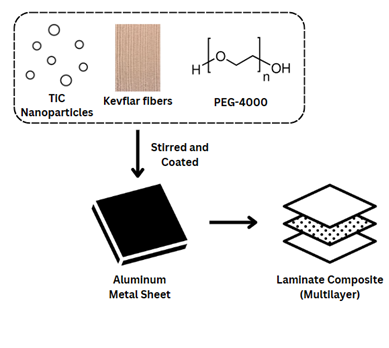Enhancing laminate composites: Investigating the impact of kevlar layering and titanium carbide nanoparticles
Abstract
The quest for innovative and superior materials is a challenge in the realm of materials science and engineering. Traditional materials often fall short in meeting the demands of modern industries, especially in the military. Technological developments in the military domain are still progressing, one of which involves a new material for combat vehicle applications: a laminated composite. In this research, a composite consisting of AA7075 sheet metal and kevlar with epoxy resin and TiC nanopowder were prepared. A test was conducted to assess its performance in absorbing ballistic energy from projectiles. Solid Thickening Fluid (STF) was created by mixing TiC nanopowder with PEG-400 through 2 hours of stirring. The laminate composite structure was prepared using the hand layup method, followed by a drying process at room temperature. The addition of kevlar layers yielded promising results in the ballistic and impact tests, as the diameter of the perforation decreased progressively with each additional kevlar layer. The IK sample impact test value improved by 35.7% compared to the unimpregnated one. The production process of this material also consumes minimal energy, which suggest a potential for environmental sustainability.
References
U. Olofsson, T. Svensson, and H. Torstensson, “Response spectrum methods in tank-vehicle design,” Experimental Mechanics, vol. 35, no. 4, pp. 345–351, 1995, https://doi.org/10.1007/BF02317544
C. Liu, S. Wang, C. Zhang, Q. Li, X. Xu, and E. Huo, “Experimental study of micro-scale organic Rankine cycle system based on scroll expander,” Energy, vol. 188, p. 115930, 2019, https://doi.org/10.1016/j.energy.2019.115930
M. Muslim et al., “Design of a combination package of heat exchanger and heater for organic rankine cycle power plant,” IOP Conference Series: Earth and Environmental Science, vol. 105, no. 1, 2018, https://doi.org/10.1088/1755-1315/105/1/012046
D. Rahmadiawan et al., “Tribological Properties of Aqueous Carboxymethyl Cellulose/Uncaria Gambir Extract as Novel Anti-Corrosion Water-Based Lubricant,” Tribology in Industry, vol. 44, no. 4, pp. 584–591, Dec. 2022, https://doi.org/10.24874/TI.1357.08.22.10
D. Rahmadiawan et al., “A Novel Highly Conductive, Transparent, and Strong Pure-Cellulose Film from TEMPO-Oxidized Bacterial Cellulose by Increasing Sonication Power,” Polymers, vol. 15, no. 3, p. 643, 2023, https://doi.org/10.3390/polym15030643
Q. Zhang et al., “Processing technology and ballistic-resistant mechanism of shear thickening fluid/high-performance fiber-reinforced composites: A review,” Composite Structures, vol. 266, no. 26, p. 113806, 2021, https://doi.org/10.1016/j.compstruct.2021.113806
A. Labanni, Z. Zulhadjri, D. Handayani, Y. Ohya, and S. Arief, “The effect of monoethanolamine as stabilizing agent in Uncaria gambir Roxb. mediated synthesis of silver nanoparticles and its antibacterial activity,” Journal of Dispersion Science and Technology, vol. 41, no. 10, pp. 1480–1487, 2020.
P. A. N. de Yro, G. H. Cariño, C. J. D. C. Sargento, and G. M. O. Quiachon, “Characterization and Antibacterial Potential of Melt Compounded Acrylonitrile Butadiene Styrene/Copper Nanoparticle Composites,” Materials Science Forum, vol. 1059, pp. 103–109, 2022, https://doi.org/10.4028/p-m6612o
D. Rahmadiawan, N. Aslfattahi, N. Nasruddin, R. Saidur, A. Arifutzzaman, and H. A. Mohammed, “MXene Based Palm Oil Methyl Ester as an Effective Heat Transfer Fluid,” Journal of Nano Research, vol. 68, pp. 17–34, 2021, https://doi.org/10.4028/www.scientific.net/jnanor.68.17
S. R. Gunakala, V. M. Job, S. Sakhamuri, P. V. S. N. Murthy, and B. V. Chowdary, “Numerical study of blood perfusion and nanoparticle transport in prostate and muscle tumours during intravenous magnetic hyperthermia,” Alexandria Engineering Journal, 2020, https://doi.org/10.1016/j.aej.2020.10.015
M. Naguib et al., “Two-dimensional nanocrystals produced by exfoliation of Ti 3AlC 2,” Advanced Materials, vol. 23, no. 37, pp. 4248–4253, 2011, https://doi.org/10.1002/adma.201102306
N. Aslfattahi et al., “Experimental investigation of energy storage properties and thermal conductivity of a novel organic phase change material/MXene as A new class of nanocomposites,” Journal of Energy Storage, vol. 27, no. July 2019, p. 101115, 2020, https://doi.org/10.1016/j.est.2019.101115
M. Boota et al., “Understanding Functionalization of Titanium Carbide (MXene) with Quinones and Their Pseudocapacitance,” ACS Applied Energy Materials, 2020, https://doi.org/10.1021/acsaem.0c00314
B. Ma’dika and A. Z. Syahrial, “Study of Aluminum/Kevlar Fibre Composite Laminate with and without TiC Nanoparticle Impregnation, and Aluminum/Carbon Fibre Composite Laminate for Anti-ballistic Materials,” International Journal of Lightweight Materials and Manufacture, 2023, https://doi.org/10.1016/j.ijlmm.2023.06.001
E. C. Tsirogiannis, E. Daskalakis, M. H. Hassan, A. M. Omar, and P. Bartolo, “Ballistic design and testing of a composite armour reinforced by CNTs suitable for armoured vehicles,” Defence Technology, no. xxxx, 2023, https://doi.org/10.1016/j.dt.2023.04.013
L. Floch, B. Da Cruz Chiochetta, L. Ferry, D. Perrin, and P. Ienny, “Fire protective surface coating containing nanoparticles for marine composite laminates,” Journal of Composites Science, vol. 5, no. 1, 2021, https://doi.org/10.3390/jcs5010006
Y. S. Lee, E. D. Wetzel, and N. J. Wagner, “The ballistic impact characteristics of Kevlar® woven fabrics impregnated with a colloidal shear thickening fluid,” Journal of Materials Science, vol. 38, no. 13, pp. 2825–2833, 2003, https://doi.org/10.1023/A:1024424200221
“Justice NI of 2000 Ballistic Resistance of Person Body Armour Law Enforce Correct Stand Test Program 1-67.”
“Annual book of ASTM Standards, E23,” 2001.
H. Foratirad, H. R. Baharvandi, and M. G. Maragheh, “Effects of dispersants on dispersibility of titanium carbide aqueous suspension,” International Journal of Refractory Metals and Hard Materials, vol. 56, pp. 96–103, 2016, https://doi.org/10.1016/j.ijrmhm.2015.12.007
A. M. Sajjan et al., “Preparation and characterization of PVA-Ge/PEG-400 biodegradable plastic blend films for packaging applications,” Chemical Data Collections, vol. 26, p. 100338, 2020, https://doi.org/10.1016/j.cdc.2020.100338
S. Mazhar et al., “Electrospun PVA/TiC Nanofibers for High Performance Capacitive Humidity Sensing,” Microchemical Journal, vol. 157, no. April, p. 104974, 2020, https://doi.org/10.1016/j.microc.2020.104974
M. Grujicic, B. Pandurangan, and B. d’Entremont, “The role of adhesive in the ballistic/structural performance of ceramic/polymer-matrix composite hybrid armor,” Materials and Design, vol. 41, pp. 380–393, 2012, https://doi.org/10.1016/j.matdes.2012.05.023
D. Chandramohan and J. Bharanichandar, “Natural fiber reinforced polymer composites for automobile accessories,” American Journal of Environmental Sciences, vol. 9, no. 6, pp. 494–504, 2014, https://doi.org/10.3844/ajessp.2013.494.504
G. Chen et al., “Contact underwater explosion response of metallic sandwich panels with different face-sheet configurations and core materials,” Thin-Walled Structures, vol. 157, no. September, p. 107126, 2020, https://doi.org/10.1016/j.tws.2020.107126
C. S. Meyer, D. J. O’Brien, B. Z. (Gama) Haque, and J. W. Gillespie, “Mesoscale modeling of ballistic impact experiments on a single layer of plain weave composite,” Composites Part B: Engineering, vol. 235, no. November 2021, p. 109753, 2022, https://doi.org/10.1016/j.compositesb.2022.109753
T. Goode, G. Shoemaker, S. Schultz, K. Peters, and M. Pankow, “Soft body armor time-dependent back face deformation (BFD) with ballistics gel backing,” Composite Structures, vol. 220, pp. 687–698, 2019, https://doi.org/10.1016/j.compstruct.2019.04.025
Z. Y. Liu, L. F. Qiu, S. W. Duo, J. Y. Lu, and Y. Y. Hou, “Synthesis and Photocatalytic Application of Mn3O4/CdS Composite,” Materials Science Forum, vol. 1054, pp. 83–87, 2022, https://doi.org/10.4028/p-38bi8w
Z. L. Chao et al., “Ballistic behavior and microstructure evolution of B4C/AA2024 composites,” Ceramics International, vol. 45, no. 16, pp. 20539–20544, 2019, https://doi.org/10.1016/j.ceramint.2019.07.033
M. A. Alazwari and S. S. Rao, “Modeling and analysis of composite laminates in the presence of uncertainties,” Composites Part B: Engineering, vol. 161, pp. 107–120, 2019, https://doi.org/10.1016/j.compositesb.2018.10.052

Copyright (c) 2023 Adinda Oktaviani, Anne Zulfia, Dieter Rahmadiawan (Author)

This work is licensed under a Creative Commons Attribution 4.0 International License.






